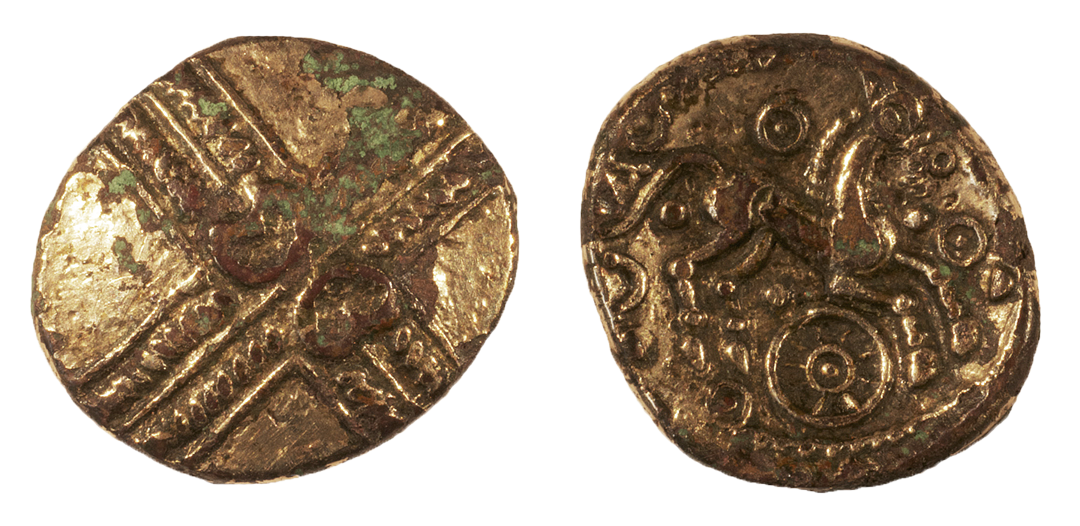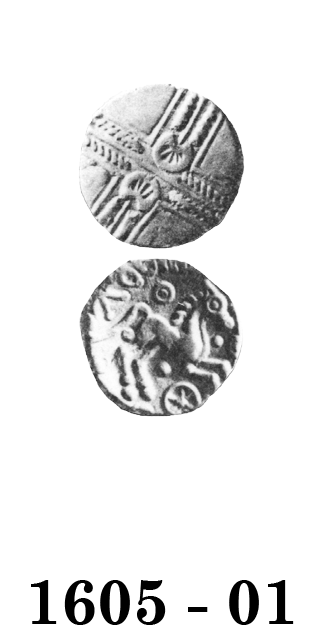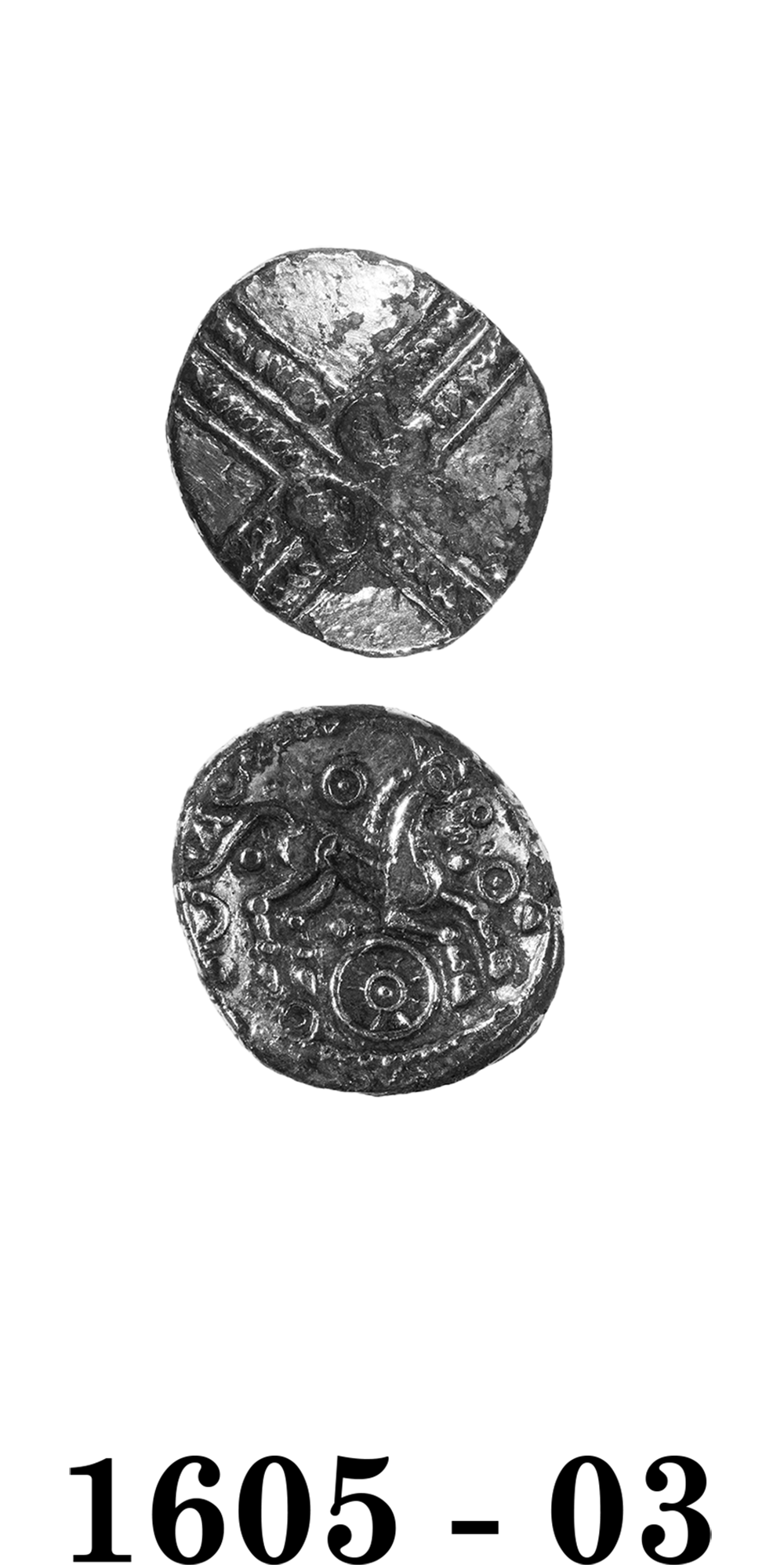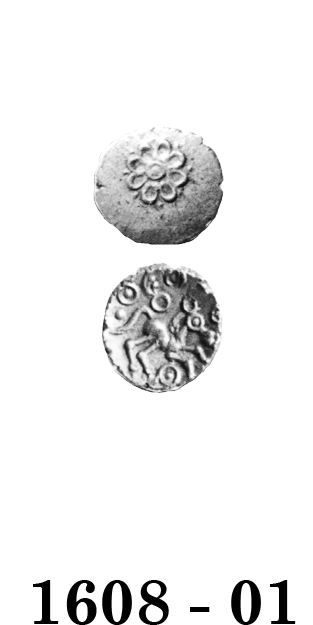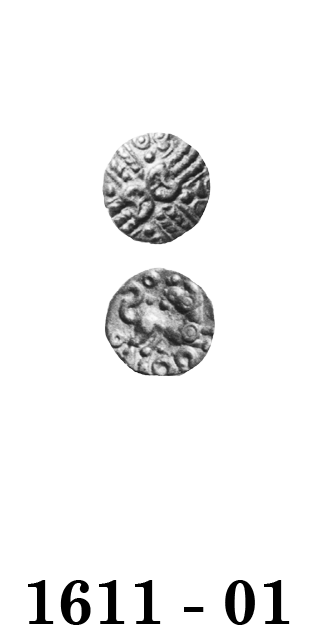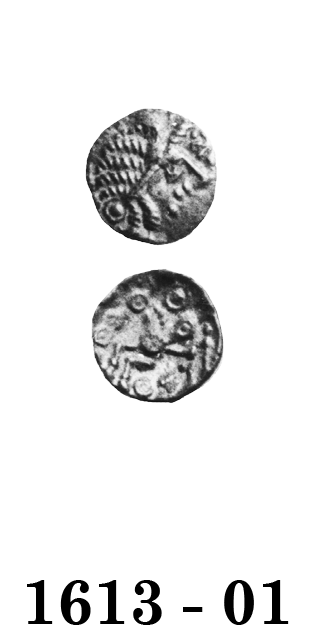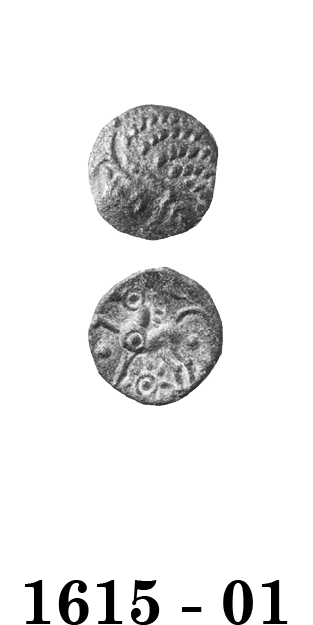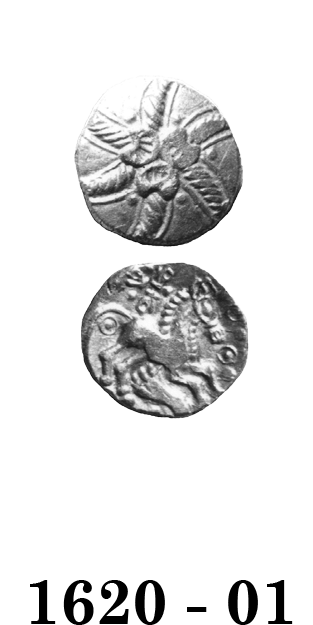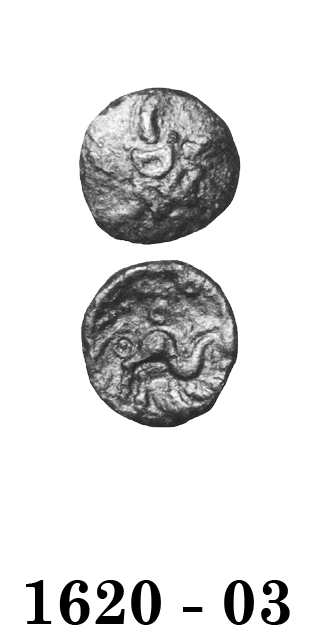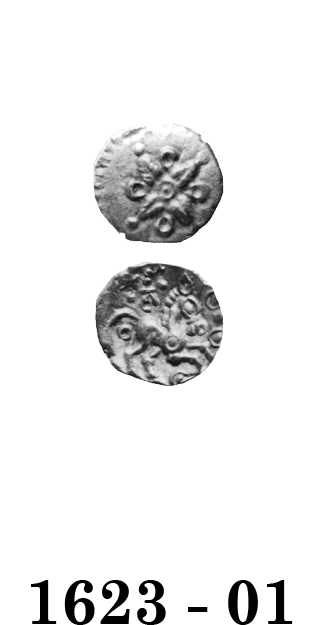
Celtic Coinage of Britain
third edition
Click on coin to see hidden information
Early Dynastic Issues of the Trinovantes and Catuvellauni
In 1944, Derek Allen published an analysis of the inscribed coins of Ancient Britain. This drew heavily on the findspot distributions of the various issues and enabled him to assign rulers to territories with better precision than had hitherto been possible. Allen thus completed the process begun by William Stukeley in the 1720's, and carried on by Akerman, Poste, Evans and Brooke.
In 1951, C. E. Stevens elaborated Allen's work by adding historical data. The resulting story presented a dramatic picture of Ancient Britain after Caesar's invasions. It described rulers interacting with Rome, squabbling amongst themselves, and generally engaging in endemic warfare. Some tribal rulers were deposed and fled to Rome for protection. A vivid imagination could allow one to see hoards of woad-painted warriors streaming back and forth between St. Albans and Colchester. It was a popular image, perpetuating the story of the Celtic tribes as primitive barbarians, ready to be included in the Roman Empire and receive the benefits of civilization.
Not everyone was satisfied with this story and the supporting details. C.F.C. Hawkes' annotated copy of Stevens' paper is covered with pencilled-in objections to Stevens' analysis. But the story was so attractive, it became the accepted wisdom of the 1950's and 60's.
By the mid-1970's too many questions were being raised, by Warwick Rodwell and others, and these brought the doubts to the fore. By 1989, in writing Celtic Coinage of Britain, most of the story was thrown out, and replaced with a "Simple Version". Two large areas, one south and one north of the Thames were ruled by a profusion of rulers in succession. A multiplicity of issuing authorities were replaced with just two – the Trinovantes/Catuvellauni and the Atrebates/Regni. The opinion was that the findspot distributions had been over-interpreted and the multiplicity of tribes could not be disentangled.
This story was, in turn, not accepted by everyone. Many wanted to retain much of the Allen-Stevens version. People were willing to go as far as ignoring the evidence to do this. Although the coinage of Addedomaros was admittedly found throughout the region north of the Thames, it was possible for one writer to "still suspect" a Catuvellaunian origin.
In 2000 and 2006, John Creighton offered a "Third Vision" of the tribal situation. This suggests a much greater role for Rome in manipulating British rulers, with British Kings perhaps raised as "obsides" in Rome. It suggests that Rome may have given military assistance to some British Rulers before the invasion of 43 A.D. It also sensibly suggests that "conquests" by one ruler over another may be little more than alliances arranged peaceably via marriages between households.
Which story is the best? Those that are most elaborate should require the most analytical support. Most of the support for multiple issuing authorities comes from findspot distributions. A careful reading of Warwick Rodwell's 1981 paper will show how dangerous this is. The findspots maps do not define where the coins were made – they define where the coins went out circulation at best. At the worst, they merely show "where people have gone looking for coins". An objection, seldom discussed, is the enormous "void" in the maps for the Greater London Area. London and its suburbs have largely obliterated any possible evidence. Such a distortion could easily create an Eastern and Western distribution, when in fact, none actually existed. Finally, the suspicion that the findspot maps have more to say about economic matters than political ones, should be taken seriously.
So which version to use, the Allen-Stevens "Endemic Warfare" one, the Celtic Coinage of Britain "Simple Version", or Creighton's "Third Vision"? Frankly, all three must be recognized for what they are - interpretations based on insufficient and sometimes unreliable data. Despite much posturing, there is little to choose between them, and certainly no proof that one is better than the others. Because this catalogue attempts to offer a picture of the structure of Ancient British Coinage, rather than just a set of photos with identification numbers, it has to choose a model. Consequently, it continues to use the "Simple Version" proposed in 1989. It admits the possibility that a more textured version may be a truer picture, and recognizes the useful contribution of Creighton to the unfolding debate.
Coinage of Addedomaros
About 40 B.C., the ruler Addedomaros added his name to the Trinovantian/Catuvellaunian gold staters. Inscriptions had already been introduced by Commius, and Addedomaros followed the practice of his neighbour.
Addedomaros' stater begins a long inscribed series and one that gives us the only insight we possess into the tribe's early leadership. Generally, the rulers are unknown to history. Addedomaros' first stater is similar to the Wonersh Type and is one of the heaviest of the inscribed Trinovantian/Catuvellaunian coins. This places Addedomaros first in the series of rulers.
Addedomaros' coinage has a definite structure and uses privy marks to distinguish the various issues. He issued three types of gold staters each accompanied by quarter staters and silver and bronze units. Because the coins are privy-marked, they are easily assembled into sets. The first series is marked by a pellet near the tail, and a wheel (or circle on the smaller coins) below the horse. The second series has a pellet-in-ring motif near the horse's tail. On the last series, the pellet-in-ring motif is moved to a position in front of the horse. The attribution of some of the silver and bronze units is somewhat arbitrary, they may be the preinscription issues of Addedomaros, instead. The arbitrarily-assigned coins are identified in the catalogue.
Addedomaros First Coinage
Addedomaros' first coinage is distinguished by a stater similar in style to the Wonersh Type. The coins are marked by a wheel below the horse, or a ring on the smaller coins, and a pellet near the horse's tail.
Addedomaros Second Coinage
The second coinage is distinguished by a new style stater in which the crossed wreaths become a six-armed spiral, and there are now three back-to-back crescents. The privy mark linking the gold, silver and bronze coins is a pellet-in-ring motif near the tail.
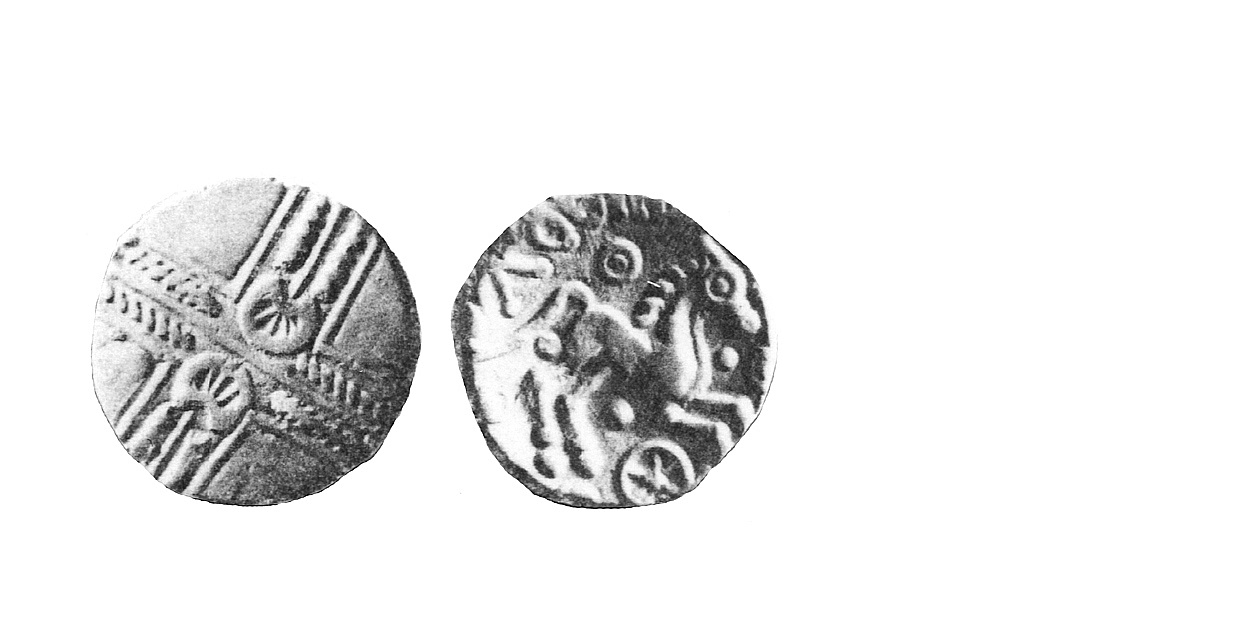
1605 - 01 Addedomaros First Coinage
40-30 B.C. Rare
Gold Stater 5.6 gms. 16 mm
Earliest Record: Poste, 1853
OBV: Crossed wreaths
Identifying points:
1) two crescents back to back
2) field in angles of wreaths is plain
REV: Celticized horse right
Identifying points:
1) pellet below tail
2) wheel under horse
3) ADDEDIIDOM above horse
CLASSIFICATION: Trinovantian I
NOTES:
- Some are in museums
- Celtic Coin Index records now indicate commoner than previously thought
- The first two Ds in the legend are sometimes the Greek letter theta, see 1605 - 05
- Standard weight given
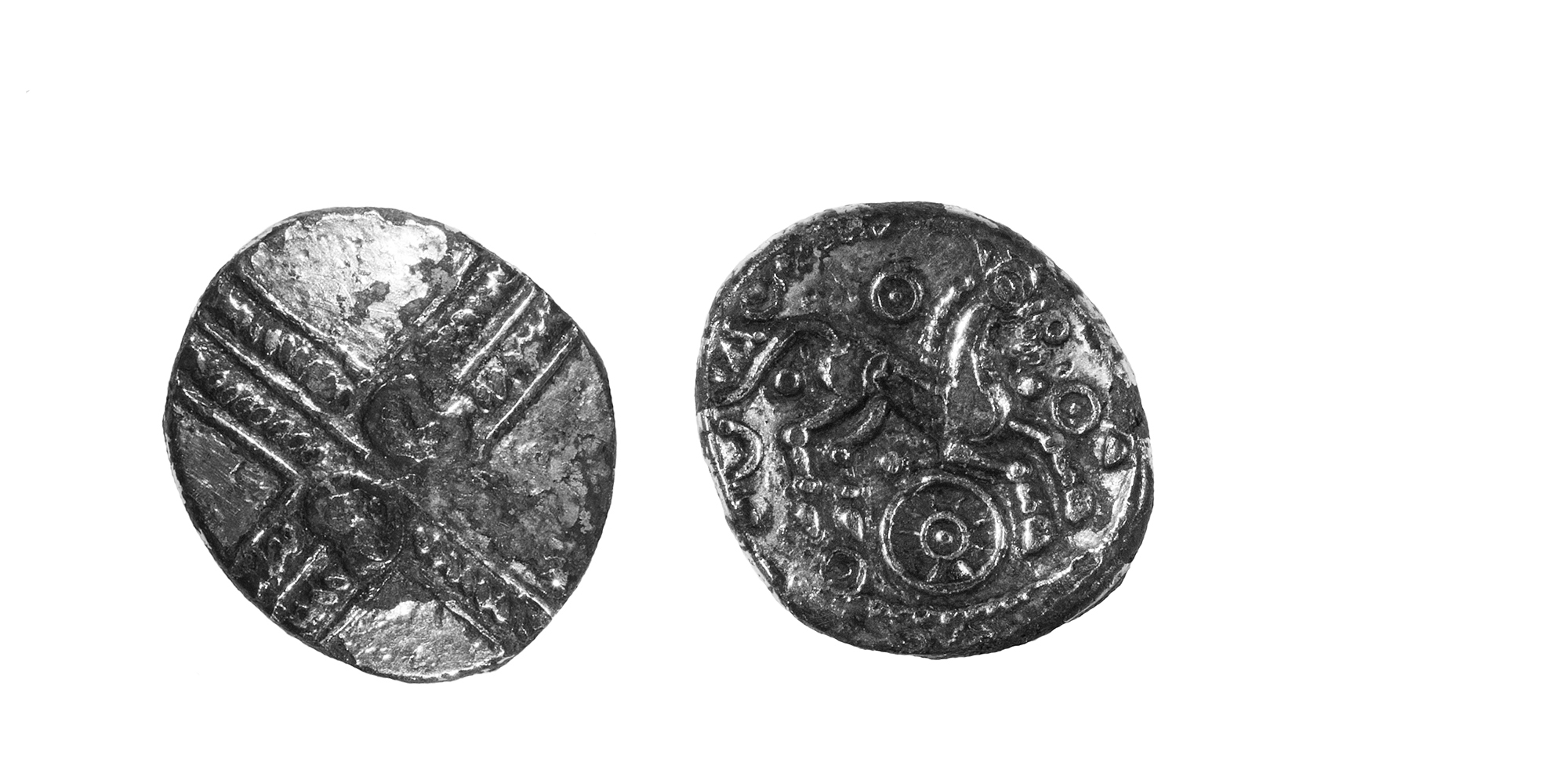
1605 - 03 Addedomaros First Coinage
40-30 B.C. Rare
Gold/Bronze Plated Stater ca. 2.90-3.98 gms. 16 mm
Earliest Record: Van Arsdell, 2017 (coins noted 1992)
OBV: Crossed wreaths
Identifying points:
1) two crescents back to back
2) field in angles of wreaths is plain
REV: Celticized horse right
Identifying points:
1) pellet below tail
2) wheel under horse
3) wheel has pellet-in-ring motif for hub
4) ADDEDIIDOM above horse
CLASSIFICATION: Trinovantian I
NOTES:
- Ancient forgery of 1605 - 01
- Weight range given based on actual weights of two coins
1605 - 05 Addedomaros First Coinage
40-30 B.C. Extremely Rare
Gold Stater 5.6 gms. 16 mm
Earliest Record: Poste, 1853
OBV: Crossed wreaths
Identifying points:
1) two crescents back to back
2) field in angles of wreaths is plain
REV: Celticized horse right
Identifying points:
1) pellet below tail
2) wheel under horse
3) DD replaced by Greek letter theta
CLASSIFICATION: Trinovantian I
NOTES:
- Standard Weight given
- Many are in museums
1605 - 06 Addedomaros First Coinage
40-30 B.C. Extremely Rare
Gold/Bronze Plated Stater 16 mm
Earliest Record: Van Arsdell, 1989
OBV: Crossed wreaths
Identifying points:
1) two crescents back to back
2) field in angles of wreaths is plain
REV: Celticized horse right
Identifying points:
1) pellet below tail
2) wheel under horse
3) DD replaced by Greek letter theta
CLASSIFICATION: Trinovantian I
NOTES:
- Ancient forgery of 1605 - 05
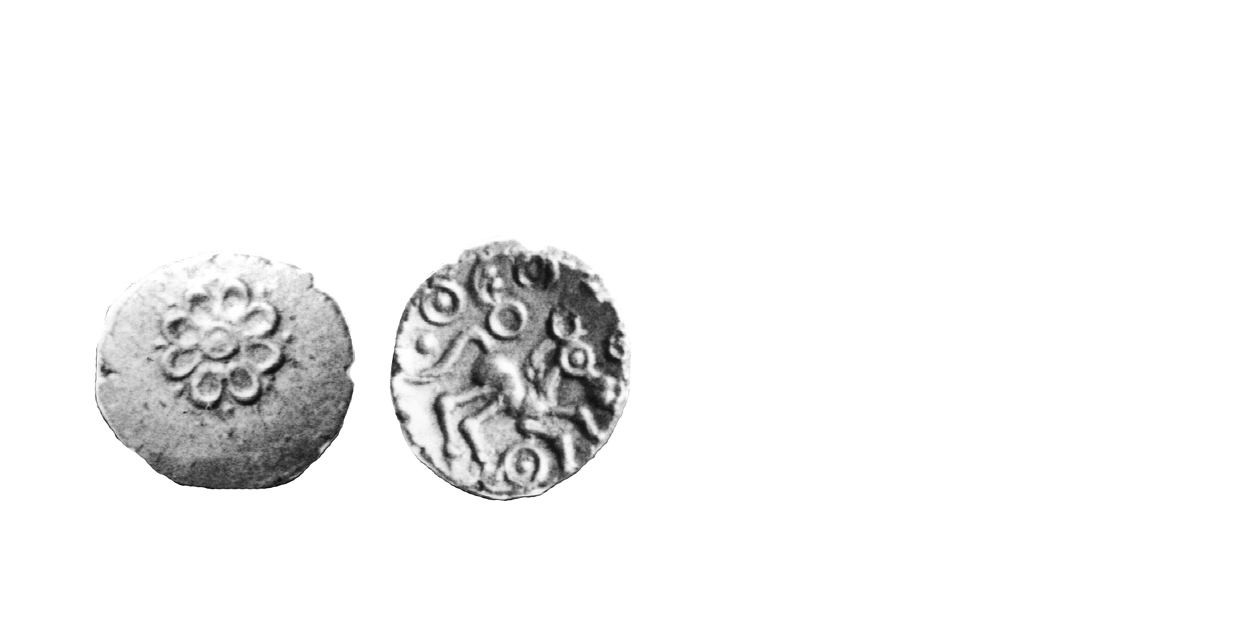
1608 - 01 Addedomaros First Coinage
40-30 B.C. Very Rare
Gold Quarter Stater 1.3 gms. 12 mm
Earliest Record: Mack, 1953
OBV: Flower
Identifying points:
1) pellet-in-ring motif in centre
2) elliptical petals form flower around pellet-ln-rlng
3) field plain around flower
REV: Celticized horse right
Identifying points:
1) pellet near tail
2) pellet-in-ring motif below horse
CLASSIFICATION: Trinovantian T
NOTES:
- Some are in museums
- Celtic Coin Index records now indicate commoner than previously thought
- Typical weight given
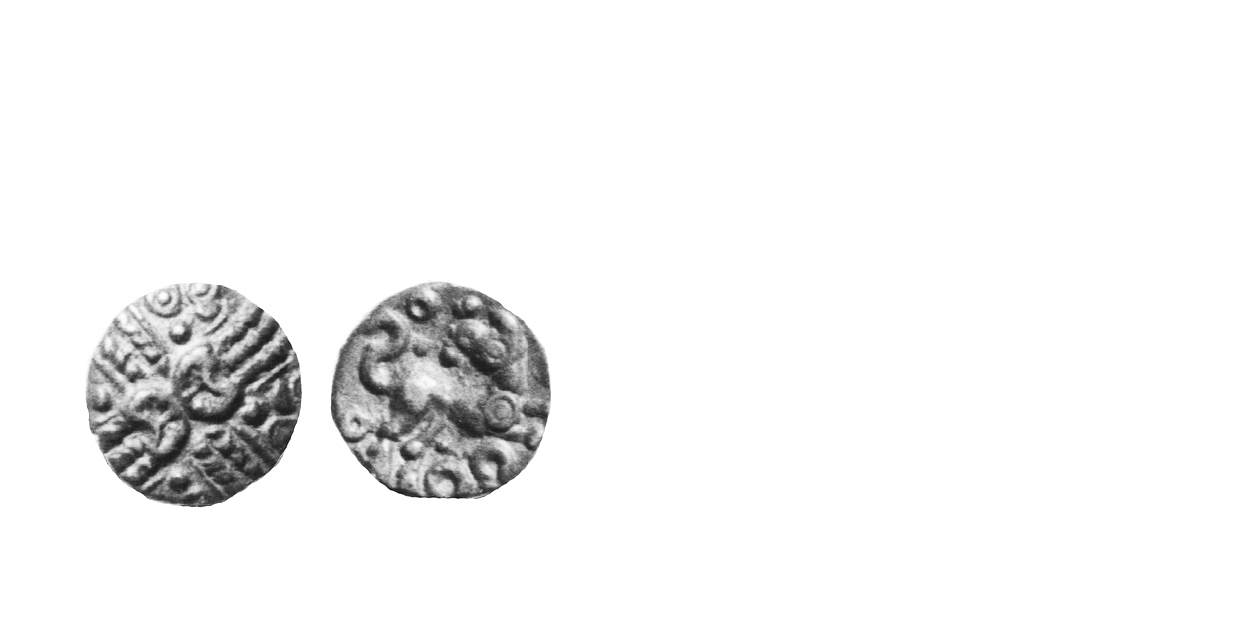
1611 - 01 Addedomaros First Coinage
40-30 B.C. Extremely Rare
Silver Unit 1.0 gm 11 mm
Earliest Record: Evans, 1864
OBV: Crossed wreaths
Identifying points:
1) similar to design of 1605 - 01
2) crescents back to back
REV: Celticized horse right
Identifying points:
1) pellet near tail
2) horse looks back to left
3) uncertain objects, possibly rings below horse
CLASSIFICATION: Trinovantian I
NOTES:
- Some are in museums
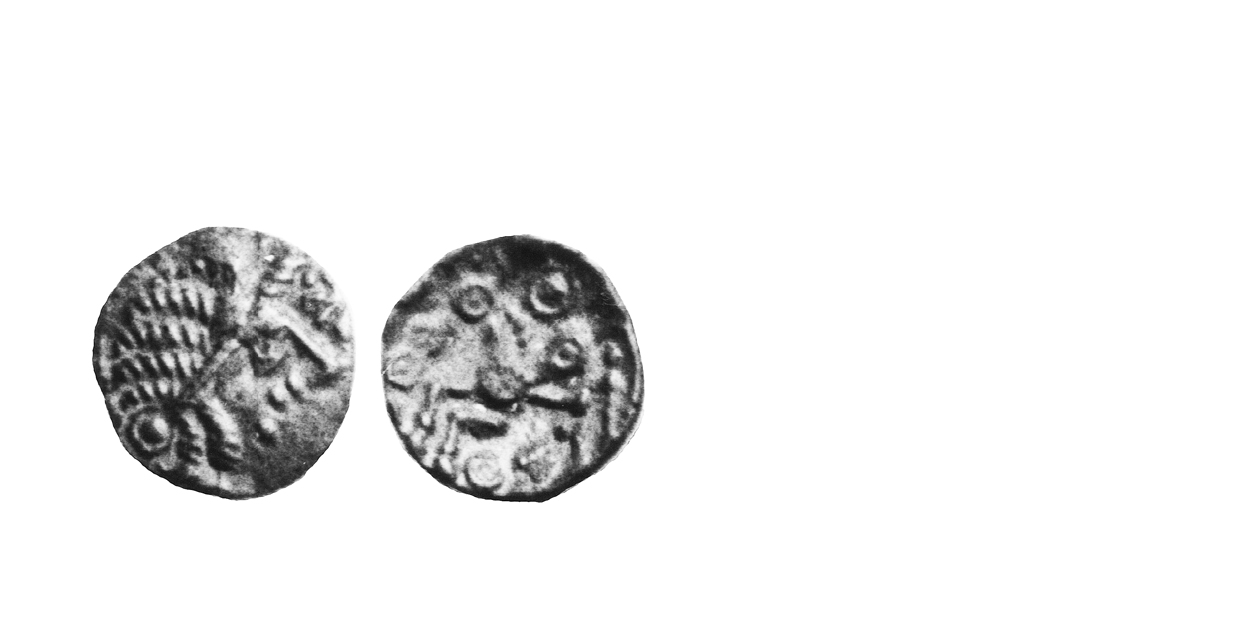
1613 - 01 Addedomaros First Coinage
40-30 B.C. Extremely Rare
Silver Unit 1.14 gms. 14 mm
Earliest Record: Mack, 1964 and France & Gobel, 1985
OBV: Celticized head right
Identifying points:
1) similar to the AE Unit 1615 - 01, but the head faces the opposite direction
2) corded hair
3) pointed nose
REV: Celticized horse left
Identifying points:
1) pellet-in-ring motif above and below horse
2) pellet near horse's tail
CLASSIFICATION: Trinovantian I
NOTES:
- From Harlow Temple excavations
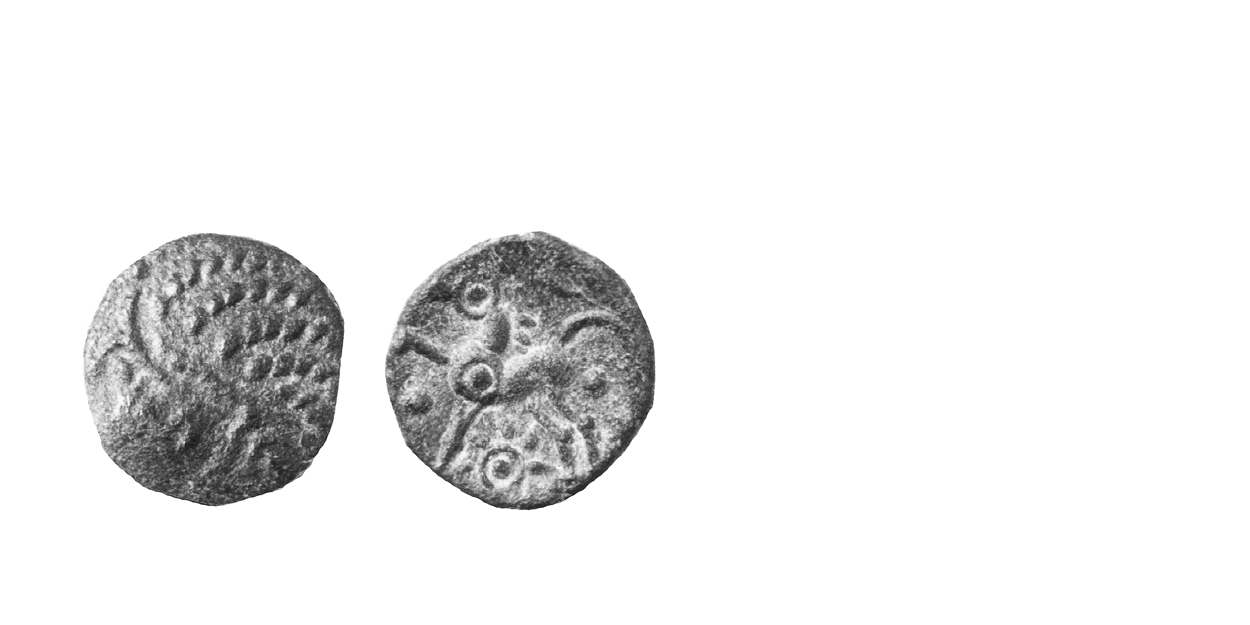
1615 - 01 Addedomaros First Coinage
40-30 B.C. Scarce
Bronze Unit 1.3-1.5 gms. 14 mm
Earliest Record: Evans, 1864
OBV: Celticized head left
Identifying points:
1) similar to the AR Unit 1613 - 01, but the head faces the opposite direction
2) corded, streaming hair
3) eye formed by pellet in inverted and curved line
REV: Celticized horse right
Identifying points:
1) pellet below tail
2) pellet-in-ring motif below horse made into flower by addition of rays
CLASSIFICATION: Trinovantian I
NOTES:
- Some are in museums
- Celtic Coin Index records now indicate commoner than previously thought
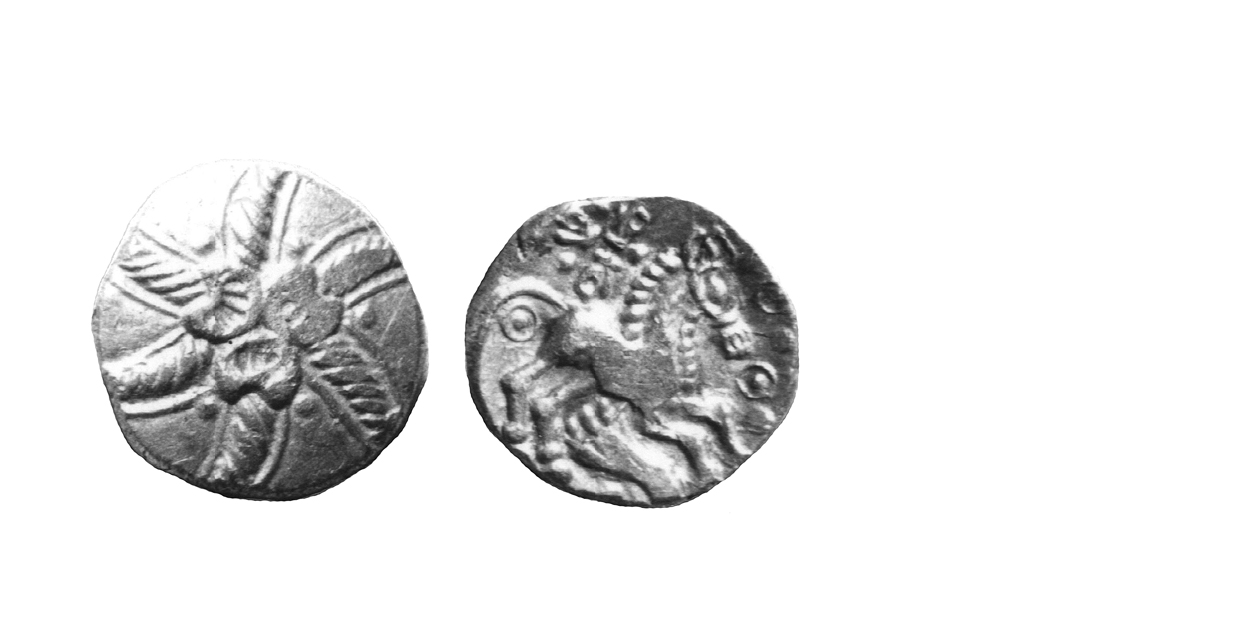
1620 - 01 Addedomaros Second Coinage
40-30 B.C. Common
Gold Stater 5.6 gms. 19 mm
Earliest Record: Poste, 1846
OBV: Six-armed spiral
Identifying points:
1) three back-to-back crescents in centre
2) spiral points clockwise
REV: Celticized horse right
Identifying points:
1) pellet-in-ring motif below tail
2) cornucopia below horse
3) ADDIIDOM above horse, first two Ds in form of Greek letter theta
CLASSIFICATION: Trinovantian J
NOTES:
- Some are in museums
- Celtic Coin Index now records large number of finds since 1989
-Standard weight given
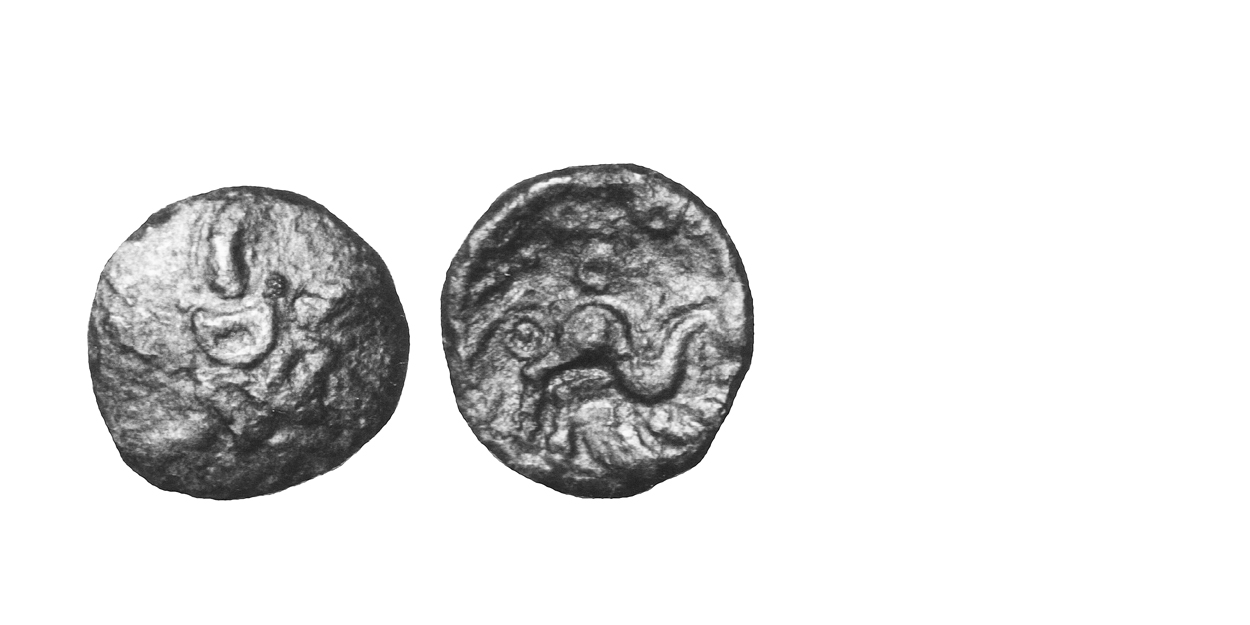
1620 - 03 Addedomaros Second Coinage
40-30 B.C. Extremely Rare
Gold/Bronze Plated Stater 3.9 gms 18 mm
Earliest Record: Van Arsdell, 1989
OBV: Six-armed spiral
Identifying points:
1) three back-to-back crescents in centre
2) spiral points clockwise
REV: Celticized horse right
Identifying points:
1) pellet-in-ring motif below tail
2) cornucopia below horse
3) ADDIIDOM above horse, first two Ds in form of Greek letter theta
CLASSIFICATION: Trinovantian J
NOTES:
- Likely ancient forgery of 1620-01
- However, possibly struck from official dies
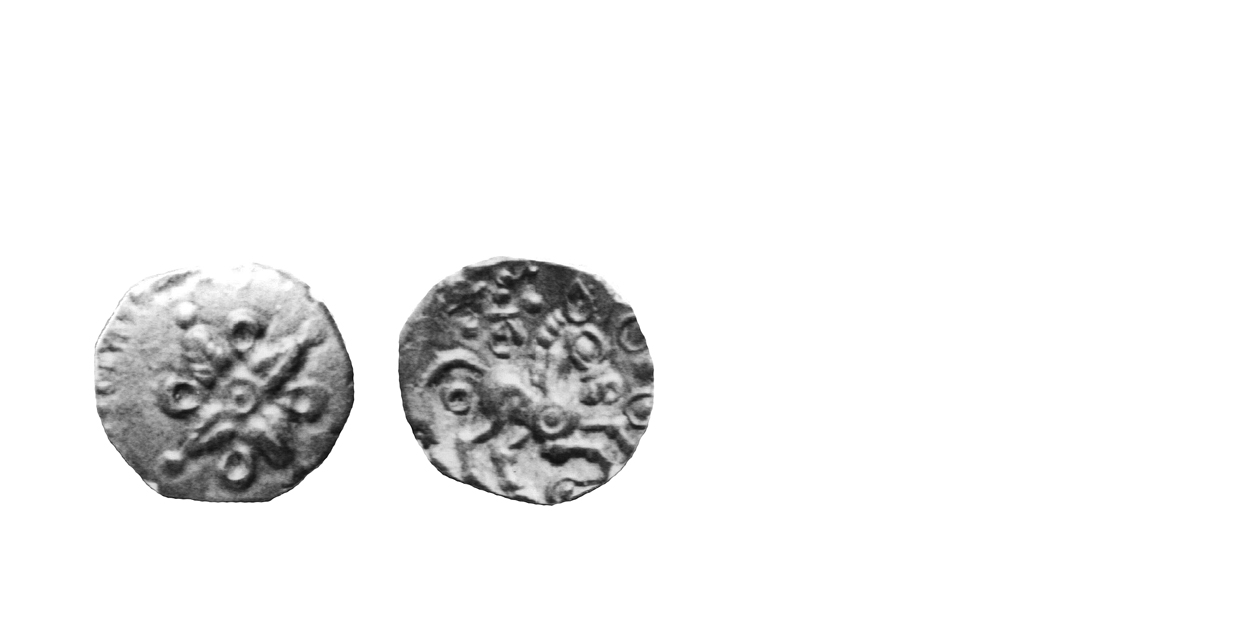
1623 - 01 Addedomaros Second Coinage
40-30 B.C. Scarce
Gold Quarter Stater 1.4 gms. 11 mm
Earliest Record: Evans, 1864
OBV: Flower pattern
Identifying points:
1) pellet-in-ring in centre
2) four ellipses form petals
3) four "arms", straightened varieties of those on 1620 - 01, form additional petals
REV: Celticized horse right
Identifying points:
1) ring under tail (too small to fit pellet)
2) pellet-in-ring motif under horse
CLASSIFICATION: Trinovantian J
NOTES:
- Many are in museums
- Celtic Coin Index records now indicate commoner than previously thought
- Typical weight given
Coinage of the Trinovantes/Catuvellauni
Traditionally, the Trinovantes and Catuvellauni were considered distinct tribes, each with its own coinage. An elaborate history, written from the coin inscriptions, described a long intertribal warfare. The Trinovantes received blow after devastating blow from the warlike Catuvellauni and lost Camulodunum, their tribal capital, several times in the process. The evidence was founded partially on Caesar's writings – the ruler of the Trinovantes had been killed by Cassivellaunus. Cassivellaunus was assumed to be a ruler of the Catuvellauni, though Caesar never stated so. The rest of the support came from an analysis of the findspots of the Dynastic coins.
Today, this history is considered a myth – the coin evidence no longer supports continual internecine warfare north of the Thames. Cassivellaunus' tribal origin is not mentioned by any contemporary writer and there is no indication he was the ruler of the Catuvellauni. The similarity of the tribal and personal names is coincidence, not a link between the two. Furthermore, recent analyses of the findspot distributions indicate the coins circulated farther afield than previously thought. The territory north of the Thames can no longer be separated into two distinct coin-using zones.
Instead, the coinage is seen today as that of a single economic group – coin types appear in succession and circulate not only throughout the area immediately north of the Thames, but into Icenian and Cantian territory as well. Metrology and typology show the inscriptions on the dynastic issues are those of successive rulers, not contemporary adversaries.
In general, the picture today is of a powerful, united tribe occupying the area north of the Thames. The unification must have occurred shortly before the Gallic War, or during it. This unified tribe had economic influence beyond its borders which increased throughout the period of the coinage. The tribal group ultimately controlled the economy of the Cantii, and to a lesser extent the economies of the Iceni and Atrebates/Regni/Belgae.
But what was this group group?
That two tribes existed is not in doubt. Caesar mentions the Trinovantes in his Gallic War commentaries, stating they were probably the most powerful tribe in southern Britain. The Catuvellauni are mentioned on an inscribed Roman stone from Hadrian's wall. There were two minting centres in the territory, at the tribal oppida of Verulamium and Camulodunum, suggesting two political centres existed. However, the coinage is a unified one since the two tribal groups must have merged into a single economic unit before they started producing coins. As a result, the tribes cannot be distinguished numismatically, and they are referred to as the Trinovantes/Catuvellauni. For all practical purposes, by the introduction of the Whaddon Chase Type about 55 B.C., they had come to act as one economically, and perhaps had been doing so as early as 125 B.C. The inscribed coinage argues for political unity by 40 B.C. as well. The dynastic coins show an orderly succession of rulers, except for a brief period around the turn of the millenium. This appears to have been an Interregnum, during which the succession was disputed.
The Trinovantes/Catuvellauni occupied the entire territory immediately north of the Thames. They were bounded on the north-east by the Iceni, on the south by the Cantii and Atrebates/Regni/Belgae, on the north the by the Corieltauvi, and on the west, probably, by the Dobunni. Thus, they were in physical contact with all the tribes of the south-east, and in a position to exert influence.
By 125 B.C.. they were importing coins from the Ambiani on the Continent, and shared the cross-Channel trade with the Cantii and Atrebates/Regni. Large Flan, Defaced Die and Abstract Type gold coins are found throughout their territory in quantity.
When the Cantii began casting bronze coins about 100 B.C., the Trinovantes/Catuvellauni followed this lead and produced their own cast coinage for a brief period. In the early 1980s a small hoard of unusual cast bronze coins was dispersed in Europe, about 100 to 300 pieces with an alleged 'Folkestone findspot'. At first this was dismissed as incorrect, and the coins branded Gaulish. However, during the late summer of 1987 a hoard of about 2,000 cast bronzes, including the unusual type, were found in a pit in the vicinity of West Thurrock, Essex. The coins occurred in at least sixteen varieties, with a reasonable typological progression. One coin had a large protrusion of flash which would have broken off had the coin been moved any great distance. In general, the hoard appeared to be made up of coins collected by a mint, perhaps for remelting. No other evidence of minting activity was noted at the site, but it appears the mint cannot have been far away.
THURROCK TYPE cast bronzes are also found as single finds in Essex. A few have been found in the Thames River and one coin was found in Dorset. Many single finds and one small hoard have been found in Kent, prompting some to the conclusion they are a Kentish issue. The coins cannot have been used for a very long time. Three interpretations are likely: 1) they have a Gaulish origin and were briefly imported, 2) they have a British origin and represent the first coinage of the Trinovantes/Catuvellauni, or 3) they are a Kentish issue. Although similar coins are reported from the Continent (Castelin, 1978, numbers 477 to 485), they are not sufficiently alike to have a common Gaulish origin. Thus, of the three interpretations, the Gaulish origin appears the least likely. The Thurrock Hoard, representing a complete corpus of the series, would have been very difficult to assemble outside the mint – it very well may be a hoard of mint scrap. Thus, the suggestion here is that the Thurrock Hoard was produced in the vicinity of the findspot – the coins representing a Trinovantian/Catuvellaunian issue.
Thurrock Types appear to have been influenced by the Prototype Period cast bronzes of the Cantii, dating them about l00 to 90 B.C. Within twenty years, the tribe was striking its own gold coinage.
The Trinovantes/Catuvellauni were one of the earliest tribes to begin striking gold staters, with the introduction of the CLACTON and NORTHERN WESTERHAM TYPES around 70-60 B.C. A hoard of the CLACTON TYPES was found with Ambiani Abstract Type staters at Clacton beach. This type, like all the early types struck in Britain was, short-lived – submerged by the large influx of Gallic War staters. About the middle of the war, the tribe began to strike the WHADDON CHASE TYPE, and continued to produce coins until the Claudian invasion a hundred years later.
The Trinovantes/Catuvellauni apparently collaborated with the Romans during the War. They probably did this by hampering trade between the Durotriges and the Armorican tribes, by competing for supplies within Britain. They may have delivered supplies directly to the Roman army, as well. The tribe obtained a large amount of gold for this effort and evidently became the recipient of wine-trading rights with the Romans. This favour ultimately gave the tribe an economic superiority over all the other tribes in the southeast after the war.
The tribe operated two mints, one at Verulamium, the other at Camulodunum. Initially, the Verulamium mint produced most of the coins, but it was overshadowed by Camulodunum in the first century A.D. The remains of both mints have been found during archaeological excavations.
It has long been asserted that Caesar gave coin-manufacturing assistance during his visit in 54 B.C., because the coins of the period display Romanizing influences. Training was probably unnecessary, however, because the moneyers would have been expert metal-workers already. The die-cutting on Whaddon Chase staters is excellent, but surprisingly, the dies were cut in soft metal. They broke up quickly and many of the existing pieces show die-damage. Sometimes depressions appear where the die surface heaved up during punching. Normally, the heaved surfaces would have been planed off, but this was not done for some reason. All this suggests that the minting was hurried, not unusual for a time of war.
The Trinovantes/Catuvellauni continued to produce coins after the War, and there appears to be little reduction in the amount produced. A silver coinage started either during the War or just after. Shortly after Commius placed his name on the Atrebatic/Regnan/Belgic coinage, the tribe began its own dynastic series, probably around 40 B.C. By this time the tribe was producing bronze coins for small change, as well as gold and silver. The series of inscribed coins gives the names of the successive tribal leaders for the next eighty years.
